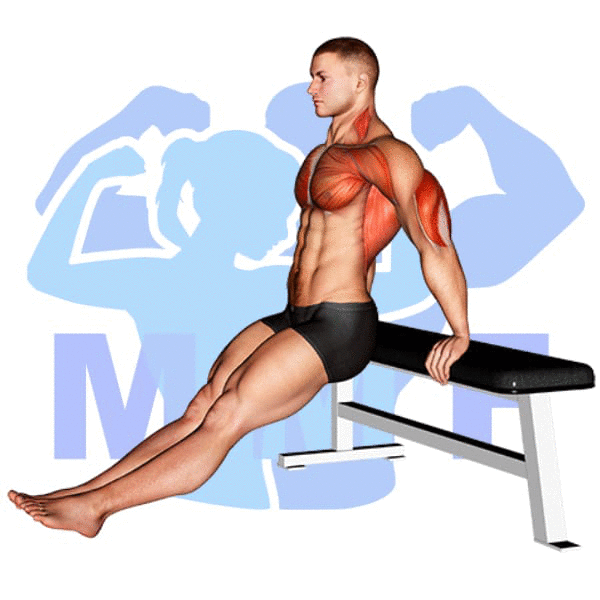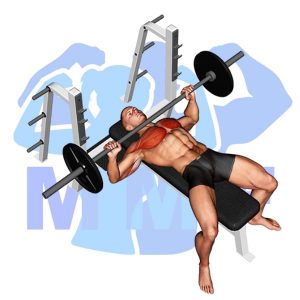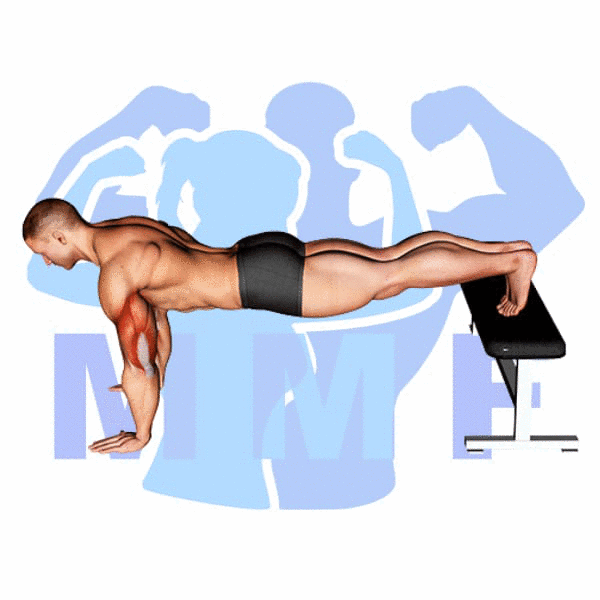Do you struggle with your form when performing a bench dip? You’re not alone. Many people face the same issue when trying to execute this exercise. It’s understandable, especially if you’re new to the fitness world. But don’t worry, we’ve all been there before. The good news is that with a little guidance, you can perfect your form and reap the full benefits of this effective exercise. In this post, we’ll break down the common mistakes made during bench dips and provide you with tips to master your technique. Stay tuned to learn how to get the most out of this powerful exercise.
Bench Dip Summary
- Primary Muscles: Triceps Brachii
- Secondary Muscles: Deltoid, Anterior, Latissimus Dorsi, Levator Scapulae, Pectoralis Major – Clavicular, Pectoralis Major – Sternal, Pectoralis Minor, and Rhomboids
- Equipment: Flat Bench
- Mechanics Type: Compound
- Force: Push
- Utility: Basic

Bench Dip Instructions
- Start by setting up perpendicular to the bench, sitting directly in the middle of the bench.
- Place your hands beside you on the bench, fingers hanging over the bench.
- Scoot your butt off the bench and move your feet out, keeping your legs straight until your body will clear the bench when you dip.
- Commence the dips by slowly lowering your body to the ground stabilizing with your hands.
- Once you reach your max contraction or just before your butt reaches the ground, press back up.
- Repeat your Bench Dip for 8-10 repetitions.
Video Tutorial
Bench Dip Muscles
Target (Agonist)
- Triceps Brachii
Synergists
- Deltoid – Anterior
- Latissimus Dorsi
- Levator Scapulae
- Pectoralis Major – Clavicular
- Pectoralis Major – Sternal
- Pectoralis Minor
- Rhomboids
Dynamic Stabilizers
Stabilizers
- Trapezius – Lower
Antagonist Stabilizers
- None

Benefits of Bench Dip
The Bench Dip is an excellent exercise for targeting the triceps brachii, a muscle located at the back of the upper arm. When performing the Bench Dip, you are able to work the entire triceps group by increasing the range of motion. This exercise helps to improve stability and strength in the triceps, allowing you to lift heavier weights with better form and control. It can also help to improve overall upper body strength and endurance. Additionally, Bench Dips are very easy to modify and can be done with or without weights depending on the level of difficulty desired.
Tips for Performing Bench Dip
You’ve landed at the right place if you desire to forge ahead your capability to conduct bench dip. Using these tips can allow you to take full advantage of this amazing workout. You’ll be able to develop your tricpes muscles, and reduce your risk of getting hurt. Let’s begin and take a look at how these tips will benefit you.
- Keep your feet in a comfortable position – Keeping your feet flat on the ground or in a comfortable position will allow you to get the most out of the exercise and keep your form correct. This will help you get a good workout and avoid any potential injury.
- Use a slow, controlled motion – Moving slowly and controlling your movements during the bench dip will ensure that you are using the right muscles and getting the most out of the exercise. It will also help you avoid straining your muscles.
- Keep your elbows close to your body – Keeping your elbows close to your body as you do the bench dip will help you keep your form correct and will allow you to get the most out of the exercise. This will help you get a good workout and help you to avoid any potential injury.
Benefits and Tips Video
Frequent Mistakes To Avoid
Avoiding common errors can be the distinction between a successful workout and a painful injury when executing bench dip. From improper form to not keeping your core engaged, these mistakes can diminish the effectiveness of the exercise and can even raise your risk for injury. But relax, it’s not quite as difficult as it might seem. By knowing the mistakes to avoid and taking the right actions, you can execute the exercise securely and effectively. So it is time for you to optimize the impact of this exercise and experience the advantages of a successful workout.
- Not using proper form: Poor form can lead to inefficient movement and potential injury. It’s important to make sure your body is in the correct position before beginning the exercise.
- Not using adequate range of motion: Not lowering your body far enough can reduce the effectiveness of the exercise and may lead to a plateau in your progress. Make sure to lower your body until your arms are at a 90-degree angle.
- Not adjusting difficulty as needed: Not increasing the difficulty of the exercise as you get stronger will prevent further progress. Start with basic form, then add weight or increase reps as you progress.
Find More Bodyweight Exercises Here
Variations and Complementary Exercises
If you are looking to build strength in the same muscles as a Bench Dip, there are some variations, complementary, and alternative exercises that can help you reach your goal. Below is a list of some of these exercises and how to perform them correctly.
Reverse Dip

Reverse Dip is a great exercise that can be used as a complementary or alternative to the Bench Dip. It is an advanced exercise that works the chest, shoulders, and triceps in a different way than the Bench Dip. To perform the Reverse Dip, you need to start by placing your hands on the edge of a bench or box, with your palms facing down. Then, slowly lower your body until your elbows are bent at about 90 degrees and your arms are parallel to the ground. From there, press your body back up to the starting position. Reverse Dip is an effective exercise for developing upper body strength and can be used in place of the Bench Dip for variety and added challenge.
Weighted Tricep Dips

Weighted tricep dips are a great alternative or complementary exercise to the bench dip. This exercise involves placing your hands on a secure surface, like a dip bar or a bench, and then dipping your body up and down while keeping your arms straight. To make it more challenging, you can add weight by holding a dumbbell or plate in each hand. This exercise is great for targeting the triceps muscles and building strength in the arms. It is also beneficial for those who cannot perform regular bench dips due to physical limitations or injury.
Chest Dip

Chest Dips are a great complementary or alternative exercise to the Bench Dip. This exercise works the chest and triceps muscles, while also engaging the core and upper back muscles. With Chest Dips, you position yourself between two parallel bars and dip down until your arms are bent at a 90 degree angle. To make the exercise more challenging, you can add weight by wearing a weighted vest or holding a plate in each hand. This exercise is great for building strength and size in the chest and triceps, making it an ideal choice for those looking to increase their upper body strength.
Check Out These Top Bodyweight Exercises
Barbell Incline Close Grip Bench Press

The Barbell Incline Close Grip Bench Press is a great alternative or complementary exercise for the Bench Dip. It works the same muscles in the chest, shoulders, and triceps as the Bench Dip, but it also puts a greater emphasis on the upper chest. This exercise also requires less range of motion than a traditional bench press and can be done at an incline, which can help target the upper chest muscles even more. It is an ideal exercise for those looking to increase their strength and power in the chest, shoulders, and triceps without having to use their entire body weight as you do with a Bench Dip.
Barbell Bench Press

The Barbell Bench Press is an effective exercise that targets the chest, shoulders, and triceps. It is a compound exercise that is often used to increase strength and muscle mass in the upper body. The Bench Dip is a great alternative or complementary exercise to the Barbell Bench Press. It primarily targets the triceps, but also works the chest, shoulders, and core muscles. The Bench Dip is an effective exercise for developing strength and muscular endurance in the upper body. It can also be used as an alternative to the Barbell Bench Press if a person does not have access to barbells or does not feel comfortable performing the Barbell Bench Press.
Barbell Incline Bench Press

The Barbell Incline Bench Press is an effective exercise that targets the upper chest muscles and can be used as an alternative or complementary exercise to the Bench Dip. This exercise requires you to lie on an incline bench and hold a barbell over your chest with your arms extended. You then lower the barbell until it touches your upper chest and then press it back up to the starting position. This exercise will help build strength in the upper chest muscles and can be used as a great alternative to the Bench Dip when performing chest exercises.
Find More Arms Exercises Here
Opposing Complementary Exercises
To maximize the results of your Bench Dip workout and ensure that your muscles are working in harmony, it is important to incorporate exercises that target the opposing muscle groups. These exercises will help to strengthen the muscles that the Bench Dip does not target and will help to create a more balanced body. Below is a list of exercises that work the opposing muscle groups of the Bench Dip.
Barbell Standing Curl

The Barbell Standing Curl is an excellent exercise to complement the Bench Dip, as it targets the opposite muscle group. The Barbell Standing Curl focuses on the biceps, which are the opposing muscle group to the triceps that are worked during the Bench Dip. This exercise is great for increasing strength and size in the arms. Additionally, it can help to improve overall shoulder stability and posture when done correctly. By alternating between the Barbell Standing Curl and Bench Dip, you can effectively work all of the muscles in your arms and shoulders, making it a great exercise combination for improving overall upper body strength.
Barbell Standing Wide Grip Biceps Curl

The Barbell Standing Wide Grip Biceps Curl is an excellent exercise for developing the biceps muscles. It works the biceps by curling the weight up towards the shoulders. This exercise is a great complement to the Bench Dip, which works the triceps, as it works the opposing muscle group. Working both the biceps and triceps together helps to promote overall arm strength and balance.
Cable V Bar Curls

Cable V Bar Curls are a great way to complement the exercise Bench Dip. This exercise involves using the cable machine to curl the weight up with a v-bar attachment. It works the biceps muscle group, which is the opposing muscle group to the triceps muscle group used in the Bench Dip. As a result, it helps to create balance in the body by working the opposing muscles and can help to ensure that both sides of the body are being worked evenly.
Dip Into Fitness: Boost Your Tricep Strength with Bench Dips
Bench dips are a simple yet effective exercise that targets your tricep muscles. All you need is a bench or sturdy surface to dip from. By performing this exercise regularly, you can increase tricep strength and definition. Remember to keep your core engaged, and avoid using momentum to push yourself up. If you’re just starting out, it’s okay to perform bench dips with your feet on the ground instead of elevated. As with any exercise, form is key to prevent injury and maximize results. So, dip into fitness with bench dips and watch your tricep strength soar!
References: Wikipedia | ExRx.net | PubMed.gov | Comprehensive List of Arms Bodyweight Exercises




